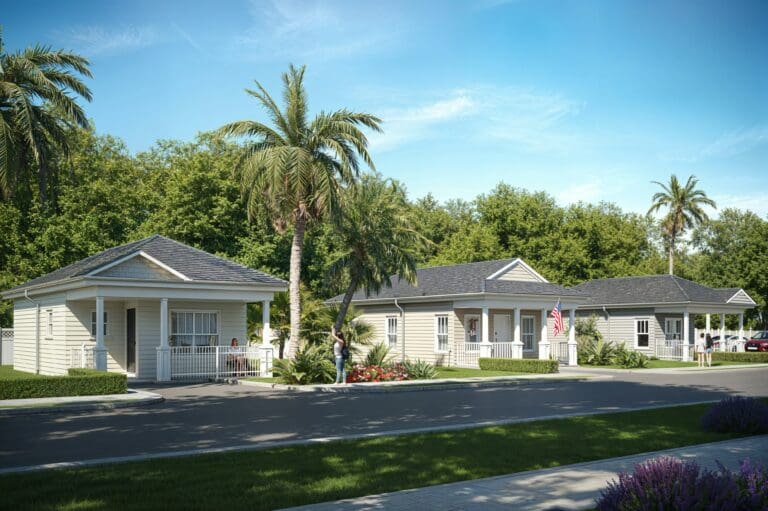The tiny home movement has become a significant trend, especially for those looking to simplify their lives and cut down on expenses. This growing interest is evident in places like Florida, where the high cost of living and rapid urbanization push people toward alternative housing options. The appeal of tiny homes is driven by cultural shifts towards minimalism and the desire for financial independence.
Living in a tiny home is about embracing a lifestyle that prioritizes essentials and cuts down on clutter. This approach is attractive to those who want to minimize unnecessary spending. The movement’s momentum has been bolstered by the realization that living in a tiny home can lead to financial independence through reduced expenses.
Cost-Saving Benefits of Tiny Homes
Tiny homes offer a financially attractive alternative to traditional housing. They are significantly cheaper to buy and maintain. The average tiny home costs between $30,000 to $60,000, a stark contrast to the $300,000 or more often required for a conventional home in Florida. This price disparity means lower mortgage payments or the chance to purchase a home outright, eliminating the need for financing.
Tiny homes are built with energy efficiency in mind, resulting in lower utility bills. The compact space reduces the need for extensive heating, cooling, and electricity, contributing to further monthly savings. Property taxes are also more affordable for tiny homes since they are based on the property’s assessed value, which is much lower than that of a traditional house.
Comparison with Traditional Housing Costs
When evaluating the financial aspects of traditional housing versus tiny homes, the advantages of the latter become evident. Traditional home mortgages often entail long-term debt and significant interest payments, creating a financial burden for many homeowners. Tiny homes provide a quicker path to homeownership, frequently without the necessity of large loans. This reduced financial pressure allows homeowners to focus on other financial goals or investments.
The financial benefits of tiny home living are especially appealing in high-cost regions like Miami and Orlando, where traditional home prices can be prohibitive. Choosing a tiny home allows residents to experience the perks of homeownership without heavy financial obligations.
Real-Life Accounts: Achieving Financial Peace
Many people have transitioned to tiny homes and gained financial independence. A couple from Tampa downsized to a tiny home after struggling with mortgage payments for years. Now, they enjoy a debt-free lifestyle, which enables them to travel and pursue personal interests.
Similarly, a family from Jacksonville moved into a tiny home to simplify their lives and focus on what truly matters. They expressed that living in a tiny home has given them the financial freedom to concentrate on their passions and spend more quality time together.
These stories illustrate the motivations behind the tiny home movement and the financial peace it can provide. Despite the challenges of adapting to a smaller living space, the benefits often outweigh the drawbacks.
The Role of Tiny Homes in Debt Reduction
Tiny homes play a crucial role in helping people reduce existing debts. By lowering monthly living expenses, residents can allocate more resources toward paying off debts faster. This financial relief can lead to increased savings and investment opportunities, paving the way for a more secure financial future.
The psychological benefits of living debt-free are also significant. The reduced financial stress associated with tiny home living can enhance overall well-being and encourage a more fulfilling lifestyle.
Potential Challenges and Considerations
While tiny home living offers numerous benefits, there are potential challenges to be aware of. Space constraints and lifestyle adjustments are common hurdles for those moving into a smaller home. It is important to plan carefully and set realistic expectations when considering this lifestyle change.
Prospective tiny home residents should also research zoning laws and community acceptance, as regulations can vary widely across Florida. Understanding these legal aspects is essential to ensure a smooth transition to tiny home living.
Community and Environmental Impact
Tiny home living encourages a sense of community, with residents often forming close-knit neighborhoods that share resources and support one another. This communal spirit is especially apparent in tiny home communities throughout Florida, where residents frequently collaborate on sustainability projects and local initiatives.
The environmental benefits of tiny homes are also noteworthy. With a smaller carbon footprint and a focus on sustainable living practices, tiny homes positively impact the environment. Communities in areas like St. Petersburg have embraced this movement, promoting eco-friendly practices and contributing to the local economy.
Designing Your Tiny Home: Creativity and Functionality
Designing a tiny home requires creativity and a focus on functionality. The limited space means that every square foot must be utilized efficiently. Many tiny homeowners opt for multi-purpose furniture and clever storage solutions to maximize their living space. This design approach not only makes the home more livable but also adds a personal touch that reflects the owner’s style and needs.
The exterior design of a tiny home can also be customized to blend with its surroundings or stand out as a unique architectural statement. Whether it’s a rustic cabin look or a sleek modern design, tiny homes offer endless possibilities for personalization. This customization allows owners to create a space that truly feels like home, despite its small size.
Building a Tiny Home: DIY vs. Professional Builders
When it comes to building a tiny home, individuals have the option to construct it themselves or hire professional builders. A DIY approach can be rewarding and cost-effective, especially for those with construction skills. Building your own tiny home allows for complete control over the design and materials used, often resulting in a more personalized space.
On the other hand, hiring professional builders can ensure a higher level of craftsmanship and adherence to building codes. Professional builders bring expertise and experience to the project, which can be invaluable, particularly for complex designs or unique features. Choosing the right approach depends on one’s budget, skills, and desired level of involvement in the building process.
The Future of Tiny Homes: Trends and Innovations
The future of tiny homes is bright, with ongoing innovations and trends shaping the movement. As technology advances, tiny homes are becoming smarter and more efficient. Solar panels, rainwater collection systems, and smart home technology are increasingly being integrated into tiny home designs, making them more sustainable and self-sufficient.
With technological advancements, the tiny home movement is also seeing a shift towards more diverse and inclusive communities. Co-housing arrangements and tiny home villages are emerging, offering shared amenities and fostering a sense of belonging. These trends indicate a growing acceptance and recognition of tiny homes as a viable housing solution for a wider range of people.
The tiny home movement offers a promising alternative for those seeking financial freedom and a more sustainable lifestyle in Florida. By embracing the benefits and addressing potential challenges, individuals can enjoy the advantages of tiny home living while contributing positively to their communities and the environment. Tiny homes not only provide an affordable housing option but also promote a simpler, more intentional way of living.
For more details on how you can start your journey toward financial freedom with a tiny home, reach out to One & Only Tiny Homes today. We can guide you through the process and help you find or build the perfect tiny home to suit your needs.


